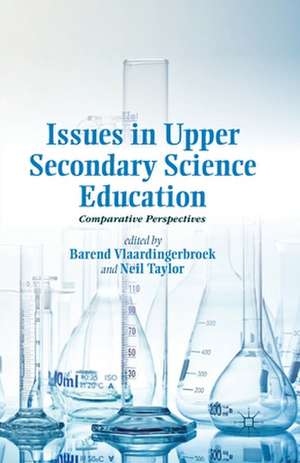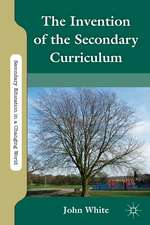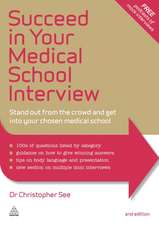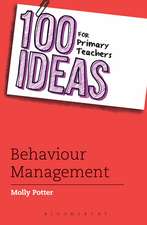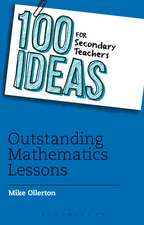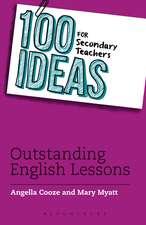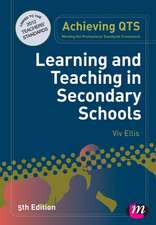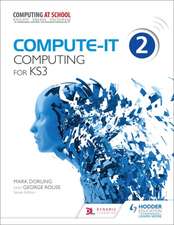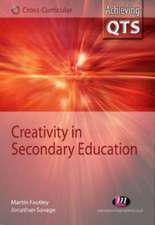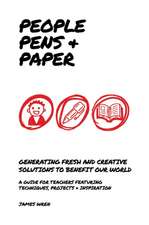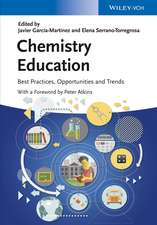Issues in Upper Secondary Science Education: Comparative Perspectives
Editat de B. Vlaardingerbroek Autor Neil Tayloren Limba Engleză Paperback – 6 mar 2014
| Toate formatele și edițiile | Preț | Express |
|---|---|---|
| Paperback (1) | 299.53 lei 3-5 săpt. | |
| Palgrave Macmillan US – 6 mar 2014 | 299.53 lei 3-5 săpt. | |
| Hardback (1) | 304.38 lei 3-5 săpt. | |
| Palgrave Macmillan US – 6 mar 2014 | 304.38 lei 3-5 săpt. |
Preț: 299.53 lei
Nou
Puncte Express: 449
Preț estimativ în valută:
57.32€ • 62.24$ • 48.15£
57.32€ • 62.24$ • 48.15£
Carte disponibilă
Livrare economică 02-16 aprilie
Preluare comenzi: 021 569.72.76
Specificații
ISBN-13: 9781349446452
ISBN-10: 1349446459
Pagini: 272
Ilustrații: VIII, 272 p.
Dimensiuni: 140 x 216 mm
Greutate: 0.33 kg
Ediția:1st ed. 2014
Editura: Palgrave Macmillan US
Colecția Palgrave Macmillan
Locul publicării:New York, United States
ISBN-10: 1349446459
Pagini: 272
Ilustrații: VIII, 272 p.
Dimensiuni: 140 x 216 mm
Greutate: 0.33 kg
Ediția:1st ed. 2014
Editura: Palgrave Macmillan US
Colecția Palgrave Macmillan
Locul publicării:New York, United States
Cuprins
Foreword; Simon McGrath 1. Introduction: The Upper Secondary Tier and the Place of Science Therein; Barend Vlaardingerbroek, Neil Taylor and Terry Lyons 2. Australia; Terry Lyons 3. Brazil; Luis Carlos de Menezes and Regina Cândida Ellero Gualtieri 4. Canada - British Columbia; Todd M. Milford 5. China - Hong Kong SAR; Benny Hin Wai Yung and Kennedy Kam Ho Chan 6. Finland; Jari Lavonen and Pasi Reinikainen 7. Hungary; András Buda 8. Malaysia; Noraini Binti Idris 9. New Zealand; Peter Rawlins, Carrol Walkley and Lone Jorgensen 10. Nigeria; Omaze Anthony Afemikhe and Sylvanus Yakubu Imobekhai 11. Pakistan; Irshad Hussain 12. Scotland; Nicky Souter 13. Sri Lanka; Marie Perera 14. Turkey; Muammer Çalik 15. The Middle East - Egypt, Lebanon, and Saudi Arabia; Saouma BouJaoude and Ghada Gholam 16. Reflections on Upper Secondary Science for the Twenty-First Century; Barend Vlaardingerbroek and Neil Taylor
Recenzii
"A variety of authors from countries across the world, and including those from both 'developed' and 'developing' countries, have provided comparative descriptions of upper secondary science education issues, and the context of the whole school systems. For those wishing to review exemplary information from well-informed writers, this book provides a wealth of global data not easily available otherwise. The writers are frank and open about the strengths and challenges in their systems, a welcome approach in these days where competition between nations might have led to 'papering over the cracks'. I strongly recommend that those interested in international comparisons include this book in their reading." - John Oversby, Science Specialist Interest Group Convenor, British Educational Research Association; Chair, Research Specialist Group, Association for Science Education, UK
"At a time of increasing globalisation, international comparisons between education systems have become ever more important. This volume brings together contributions from 13 countries and one region (the Middle East) to provide a valuable perspective on key issues in upper secondary science. The result is both informative and, in places, quite surprising. This is a book that should be of value to anyone looking to improve their country's secondary science education or to understand how it compares in its organisation to other countries." - Michael J Reiss, Professor, Institute of Education, University of London, UK
"I highly recommend this book to secondary science teachers and educational policy personnel, no matter what country they come from, as the book is a fascinating, accurate and up to date account of the issues facing secondary teachers around the world. The book fills in the gap in educational writing on science teaching. As a secondary teacher in Australia who teachers mainly senior secondary classes I found myself in agreement with many of the explanations and opinions put forward by the outstanding group of contributing authors in this well written book based on current research on policy and its application." Stephen Zander, President of the Australian Science Teachers Association
"Barend Vlaardingerbroek and Neil Taylor provide a fresh and concise summary of the progress of science teaching. The complementary chapter structure allows the reader to easily compare the motives and strategies employed in teaching modern science, both junior and senior, in a variety of jurisdictions around the world. This book is an excellent starting point and reference for anyone looking to compare how and why science is being taught around the globe." - Ross Hudson, Research Fellow, Australian Council for Educational Research
"At a time of increasing globalisation, international comparisons between education systems have become ever more important. This volume brings together contributions from 13 countries and one region (the Middle East) to provide a valuable perspective on key issues in upper secondary science. The result is both informative and, in places, quite surprising. This is a book that should be of value to anyone looking to improve their country's secondary science education or to understand how it compares in its organisation to other countries." - Michael J Reiss, Professor, Institute of Education, University of London, UK
"I highly recommend this book to secondary science teachers and educational policy personnel, no matter what country they come from, as the book is a fascinating, accurate and up to date account of the issues facing secondary teachers around the world. The book fills in the gap in educational writing on science teaching. As a secondary teacher in Australia who teachers mainly senior secondary classes I found myself in agreement with many of the explanations and opinions put forward by the outstanding group of contributing authors in this well written book based on current research on policy and its application." Stephen Zander, President of the Australian Science Teachers Association
"Barend Vlaardingerbroek and Neil Taylor provide a fresh and concise summary of the progress of science teaching. The complementary chapter structure allows the reader to easily compare the motives and strategies employed in teaching modern science, both junior and senior, in a variety of jurisdictions around the world. This book is an excellent starting point and reference for anyone looking to compare how and why science is being taught around the globe." - Ross Hudson, Research Fellow, Australian Council for Educational Research
Notă biografică
Simon McGrath, University of Nottingham, UKTerry Lyons, University of New England, AustraliaLuis Carlos de Menezes, University of São Paulo, BrazilRegina Cândida Ellero Gualtieri, Federal University of São Paulo, BrazilTodd M. Milford, Griffith University, AustraliaBenny Hin Wai Yung, University of Hong Kong, Hong KongKennedy Kam Ho Chan, University of Hong Kong, Hong KongJari Lavonen, University of Helsinki, FinlandPasi Reinikainen, Finnish Education Evaluation Council, FinlandAndrás Buda, University of Debrecen, HungaryNoraini Binti Idris, Sultan Idris Education University, MalaysiaPeter Rawlins, Massey University, New ZealandLone Morris Jorgensen, Massey University, New ZealandCarrol Walkley, Massey University, New ZealandOmaze Anthony Afemikhe, University of Benin, NigeriaSylvanus Yakubu Imobekhai, University of Benin, NigeriaIrshad Hussain, Islamia University of Bahawalpur, PakistanNicholas Souter, University of Strathclyde, UKMarie Perera, University of Colombo, Sri LankaMuammer Çalik, Karadeniz Technical University, Turkey Saouma BouJaoude, American University of Beirut, Lebanon Ghada Gholam, UNESCO (Cairo Office), Egypt
